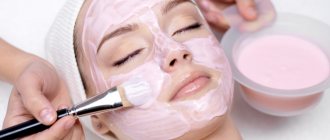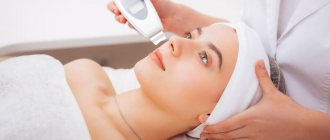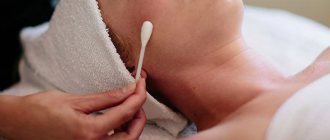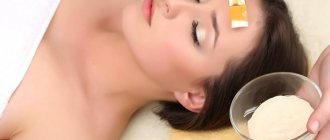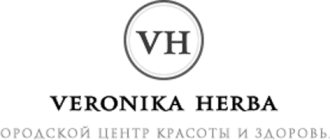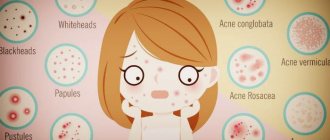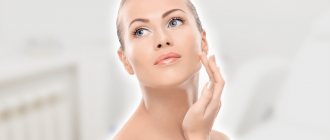It's time to explore the question: peeling or facial cleansing - which is better? After all, as you know, there is no limit to perfection and every woman strives to find new ways to make her appearance irresistible.
Modern cosmetology offers many procedures that help eliminate external light defects and deeper skin problems. With the help of not so complicated manipulations, you can stop the aging process, remove age-related changes, or at least effectively fight them.
Experts are categorically against comparing procedures such as cleansing and peeling. Their similarity is only that they act on epidermal tissue. But the methods, mechanisms and achieved results are different.
What is the difference between the procedures?
Peeling and facial cleansing have completely different characteristics, indications for procedures, age criteria, methods and methods of manipulation.
The main difference between peeling and cleansing is the use of acid-based solutions. The compositions rid the skin of the upper keratinized layers of the epidermis, which no longer fulfill their “functional duties”, acting as ballast, preventing regeneration and cell renewal, and preventing proper breathing, nutrition and moisturizing of the skin.
Products applied to the surface destroy dead layers. As a result, the skin begins to peel off and completely renew itself. The depth of impact on epidermal tissue depends on the composition chosen by the cosmetologist.
What is the difference between cleansing and peeling? First of all, it is designed to solve specific gaps locally. That is, using this method you can get rid of visible defects (pimples, blackheads, comedones, sebaceous plugs) that are located in the deep layers of the epidermis and require mechanical effort to remove.
To carry out cleaning, the master can use various devices, or perform manual manipulation using special tools.
The difference between the procedures is also in the rehabilitation period:
- After peeling, recovery occurs with the inevitable side effect - peeling. Depending on the depth of impact, rehabilitation time can last from a week to four, sometimes even ten;
- After cleaning, other side effects are possible in the form of bruises and hemorrhages in places where particularly deep inclusions were removed. However, recovery is faster - up to two weeks maximum.
It is also worth paying attention to the fact that sometimes cosmetologists advise combining cleansing and peeling. But this factor is of a purely individual nature. More on such nuances a little later.
Combination rules
Many patients are interested in whether it is possible to do both cleansing options at once. According to ordinary people, this will bring a double positive effect.
Cosmetologists do not recommend performing both procedures at the same time. The best option: preliminary preparation of the skin using cosmetics with a slight exfoliation effect. It is acceptable to exfoliate using products with minimal acid content, right before cleansing.
Perform standard professional peeling (acid concentration 20–50%) with any depth of impact, it is recommended at intervals of 1–4 weeks before or after cleansing. More precisely, the gap interval will be determined by a cosmetologist.
Attention! There is an option to “close” the cleaning with peeling. Cosmetologists use light acid preparations. Exfoliation is not done if the integrity of the tissue is damaged. Mechanical cleansing of pores is not performed if the stratum corneum is excessively thick and covers the ducts.
The doctor can prescribe the sequence of procedures. If the pores are excessively clogged, it is recommended to first clean them, after healing, and if there is no inflammation, peel them. If the skin is excessively thickened and dehydrated, then it is better to initially choose peeling.
Peeling - the secrets of the procedure
First of all, let's consider the indications for peeling:
- increased skin oiliness;
- hyperpigmentation (including age-related);
- age-related changes;
- wrinkles, deterioration of turgor;
- dull complexion.
Experts say that this procedure can be used for any skin type.
Facial restoration by a cosmetologist using peeling can be done in different ways. Procedures are divided into types, which in turn have subtypes.
Mechanical peeling is the most common and safe. According to another classification, it is classified as surface effects. However, here too the depth of penetration of the composition into the epidermis is somewhat different and depends on the specific subtype of the procedure:
- using simple scrubbing compounds. The effect is reminiscent of a massage. Removes the topmost layer of keratinized cells;
- gommage – based on fruit acids. Dissolves and removes the top layer more efficiently, touching the second layer of the epidermis (it consists of five layers);
- microdermabrasion and coral peeling are rougher, but also more effective. The mechanism of action is based on the dispersal of grains included in the composition of the product by a special apparatus.
It is at the same time as mechanical peeling that cosmetologists may recommend cleaning if the skin is very problematic and requires an integrated approach. But let us remind you once again - everything is purely individual!
Physical peeling (according to another classification - medium) also varies in depth of impact. The second or third layer of the epidermis is affected. During the procedure, liquid nitrogen or dry ice is used. The result is restoration of complexion, improvement of oxygen breathing, stopping the processes of skin dehydration
Chemical, deep, phenol peeling is a way to completely remove all old skin. Almost all layers of the epidermis are affected, which are literally dissolved by the aggressive composition. All that remains is the so-called “growth zone” - a thin layer of cells that creates new skin. This method is very controversial; it is not used without special indications.
The procedure is carried out in a hospital setting using strong painkillers (sometimes even general anesthesia), since the pain is very strong. The rehabilitation period also takes place in a hospital, at least two weeks (sometimes up to four). The entire recovery period requires the implementation of special rules, at first - taking painkillers. Its duration can reach up to ten weeks.
Description of cosmetic procedures
Peeling
Peeling removes the stratum corneum of the dermis using solutions that contain different concentrations of acids - fruit, glycolic or trichloroacetic. Such exfoliation helps to normalize metabolic processes, strengthen the protective functions of the epidermis and activate regeneration processes.
Indications for the procedure:
- disruption of the sebaceous glands;
- age spots or freckles;
- the first signs of aging;
- deterioration of skin color.
Contraindications for peeling:
- viral diseases;
- high blood pressure;
- sensitive epidermis;
- cardiovascular diseases;
- pregnancy or breastfeeding;
- psychological illnesses.
Face cleaning
Cleansing is a mechanical procedure for cleansing the dermis of acne, excess fat, acne and other impurities, performed manually or using various professional devices, such as a Uno spoon or a Vidal needle. It helps eliminate:
- acne;
- acne and negative consequences of the disease;
- sebaceous plugs.
Cleaning is not recommended during menstruation - at this time, due to hormonal changes, the pain threshold increases. If fungal and viral diseases are detected on the face, cleaning should be postponed until the existing problem is cured.
Peeling or cleaning is not done if intolerance to the components included in the selected products is detected, with an active form of herpes, skin diseases, or ulcers.
Facial cleansing - what you need to know
By analogy, let’s consider the indications for facial cleansing:
- increased oily skin with enlarged pores;
- comedones (deep and superficial);
- pimples, closed and open;
- millet (millions);
- acne and post-acne;
- hyperpigmentation (including freckles and age spots);
- sebaceous plugs.
A cosmetologist will advise you on which facial cleansing method to use. But in this case, performing a home procedure is safer than peeling. The manipulation is not so aggressive and does not require the use of chemical compounds that can cause an unpredictable reaction.
Cleaning is indicated for those with problematic, oily skin prone to the formation of pimples, blackheads, and sebaceous plugs. But with normal or combined epidermis, sometimes it is also necessary to get rid of the above problems.
Facial cleansing can be carried out both by the hands of a master and using hardware techniques:
- mechanical (manual, manual) - after the preparatory stages, the cosmetologist removes all destructive fragments by hand or with special tools (Unna spoon, Vidal needle, metal loops, brushes);
- Vacuum is carried out using a device that creates negative pressure in a special nozzle. The action is similar to a vacuum cleaner - all the dirt from the pores is sucked out;
- Ultrasonic cleaning is one of the gentle methods with a prolonged effect. Under the influence of ultrasonic vibrations applied to a special scrubber, dirt, sebum, keratinized epithelium and small destructive elements are removed;
- disincrustation (galvanic cleaning) is comparable in effect to manual cleaning. Under the influence of microcurrents, the contents of the pores are broken down and removed;
- laser cleaning – removal of all problem areas using a laser. A good procedure that makes it possible to effectively combat age-related changes.
Another important nuance is that cleansing can be carried out in adolescence, when skin problems arise due to hormonal changes. Whereas peeling is only after 30 years, in rare cases after 25 according to individual indicators.
What to choose
A cosmetologist will help you make a choice in favor of cleaning or peeling. The procedures often complement each other. It is impossible to put an equal sign between them. The influences are aimed at obtaining different results. The effect of the procedures is compatible, but not comparable.
A cosmetologist can give a clear answer to the question of choice. The doctor will assess the skin condition and select a care program. Often the cosmetologist's response is to convince him of the need to perform two procedures sequentially.
If we talk about the primary need for this type of intervention, then cleansing is prescribed for those with oily, combination skin with acne and pimples. Peeling is mandatory for hyperkeratosis, the presence of age spots, scars, wrinkles, and decreased tissue turgor.
To combine or not to combine - that is the question
Peeling and cleansing, by and large, are procedures designed to solve the same issues. This is their similarity. But the mechanism of action is completely different. We conclude that they may well complement each other, especially when solving significant problems.
The question naturally arises: is it necessary to cleanse the face before peeling? What is better - peeling or cleansing first? Is it possible to exfoliate without cleansing your face and vice versa?
Don't try to solve this dilemma on your own. Leave it to the professionals to decide what to do in each case. Only after diagnosis will they tell you what is best.
Do I need to do peeling and cleansing?
The easiest excuse is everyday activities, household chores, lack of time or funds. In fact, both procedures do not take much time. Facial cleansing or peeling at home also requires money and time, and without special knowledge they often lead to the opposite result.
Healthy facial skin and a well-groomed, successful appearance require you only to consult with a cosmetologist and attend the procedure itself. A cosmetologist will determine the degree of cleansing required and the methods recommended in a particular case, and in the salon they will carry out everything prescribed by the doctor and put in order your business card - your face.
Take care of yourself. Be beautiful at any age. We also recommend that you familiarize yourself with glycolic peeling at home in this material.
Are there any contraindications?
Like every cosmetic procedure, cleansing and peeling have their own direct contraindications.
Facial cleansing should not be carried out in the following cases:
- individual intolerance;
- the presence of dermatological pathologies;
- herpes in acute form;
- hypertonic disease;
- mental disorders;
- dry, sensitive surface of the epidermis;
- critical days, a couple of days before and after - there are hormonal disruptions, the pain sensitivity threshold increases.
For peeling, there are the following prohibitions:
- individual intolerance;
- very sensitive skin.
- dermatological diseases;
- infectious diseases;
- elevated body temperature, regardless of the cause;
- hypertension;
- heart and kidney diseases;
- herpetic infection;
- mental disorders;
- pregnancy and lactation period.
Impacts on the skin should not be carried out during menstruation, a few days before and after it.
A cosmetologist about what is better:
Be careful: medical contraindications
If the decision is made, carefully read the following list of medical contraindications.
Cleaning should not be carried out under any circumstances:
- In the presence of fungal, inflammatory, viral and infectious diseases on the face, unless they are cured before starting the procedure;
- If there are severe diseases of internal organs and any neoplasms (this also applies to peeling);
- If you have rosacea, trichosis, herpes and cheilitis;
- With increased fragility of blood vessels.
- If you have temporary health problems. You can learn about peeling with calcium chloride in this article.
Peeling is contraindicated in the following cases:
- During pregnancy and breastfeeding;
- For viral diseases accompanied by high temperature, in particular fever;
- For pustular diseases on the skin and herpes;
- For any cancer;
- .For serious diseases of the cardiovascular system;
- For allergic diseases or allergies to certain substances.
Recommendations from cosmetologists
Chemical peeling and facial cleansing are procedures that, to a greater or lesser extent, still injure the epidermis. Cosmetologists advise following simple rules to speed up the recovery process.
After peeling you need:
- do not wet your face for 24 hours (if you used deep chemical peeling – up to 3-4 days);
- Do not remove developing crusts under any circumstances;
- do not visit places with high humidity and air temperature (sana, bathhouse, swimming pool, beach);
- do not sunbathe or visit a solarium;
- do not use products containing alcohol;
- apply moisturizing and nourishing creams according to your skin type;
- Use sunscreen before going outside.
After cleansing your face you should:
- do not wash your face for a day, wipe your face with soothing, cleansing lotions without alcohol;
- Do not forcibly tear off crusts if they form;
- do not expose your face to sunlight for two days;
- sauna, baths, swimming pools, beaches - taboo for at least a week;
- preference should be given to cleansing gels and alcohol-free lotions with a calming effect;
- Apply moisturizing and nourishing products according to your skin type. If necessary, use healing ointments.
The cosmetologist will tell you how often to do the procedure.
Patient reviews
Patients have a positive attitude towards exfoliation. Many people choose this method of deep skin cleansing. Opinions about mechanical sanitation of pores are often negative. Patients see the procedure as a temporary solution to the problem, but at the risk of worsening the situation.
Opt for peeling.
The patient does not approve of regular cleanings and advises establishing daily care.
Reviews
We have already figured out how peeling differs from facial cleansing. Reviews will help you get a complete picture.
Victoria, 25 years old, Moscow
“I cleanse regularly because I have oily, problematic skin. Recently, a cosmetologist advised me to peel my face with fruit acids a week after cleansing. The effect is amazing. This procedure complemented the cleaning, made it better and longer lasting.”
Marina, 32 years old, Ramenskoye
“When I asked what is better to cleanse my face - peeling or ultrasonic cleansing, the master at the salon told me that it was too early for me to think about peeling, since the skin looked quite good. I understand that it is not at all necessary to “burn” your face unless absolutely necessary.”
Oksana, 48 years old, St. Petersburg
“I did peeling with liquid nitrogen. The exfoliation took place for at least two weeks. It’s good that you took a vacation, otherwise at least don’t show up for work. But there is an effect - the face has become fresher, the spots have disappeared"
Tatyana, 40 years old, Ryazan
“Ultrasound facial cleansing is the best procedure for me. I do it regularly and am quite pleased with the result. But a friend went to get a chemical peel and I didn’t see her for a month. She didn't even invite me to visit. Only later did she tell me what a nightmare it was. I definitely won’t do that.”
Olga, 35 years old, Tomsk
“I have been using scrubs with fruit acids on my own for a very long time. As it turned out, this is also peeling, which is not so scary. It’s probably time to contact a cosmetologist for a professional service.”
A Dilemma That Doesn't Exist
At first glance, a beginner faces a difficult choice problem, which in fact does not exist. If there are no medical contraindications, and the budget allows you to take care of yourself, you need to do both procedures. There is no need to decide whether facial cleansing or peeling is better. Cosmetologists usually advise peeling after cleansing has already been done.
Cleaning is necessary in any case, even with daily procedures involving wiping the face, applying nourishing compositions and masks to the face, washing with special products and rubbing in cream. If you do this regularly, cleaning is especially necessary, because everything applied gets into the pores, and the sebaceous secretion is still released, and dust and dirt settle on it. You can find out about peeling at home with calcium chloride at the link.
It is best to contact a cosmetologist who will carefully examine your face, diagnose all disorders and draw up a list of necessary procedures. Perhaps it's not that bad and a simple cleaning is enough. Otherwise, you will have to use a combination one, organically combining several types.
Since this in any case injures the soft tissues of the face, many are of the opinion that peeling should be carried out after the tissues return to normal. But there is also the opposite opinion that the procedures should be carried out one after another, and then the effectiveness will be higher.
Facial peeling is absolutely necessary if there are wrinkles, keratinization of the upper layer of skin, pigment spots, capillary mesh, poor vascular function, infiltrates and peeling. It is indispensable for violation of facial contours, stretch marks and decreased tone.
If you cleanse before peeling, its effectiveness will be much higher. A good facial peel usually produces excellent results.
How it works
Essentially, this type of peeling is a combination: a dioxide mixture that exfoliates dead epidermal cells, combined with laser heating. Contaminants located in the pores are drawn out by the nanogel. The most delicate and safest laser in comparison with other types of laser is used - neodymium. Its task is to remove dead skin cells while stimulating the production of new ones. Often, the result is noticeable after three to five sessions. If the dermis is too advanced, a course of seven procedures may be required. At the same time, expect that ten or more days should pass before each subsequent one (more precisely, your cosmetologist will tell you). The skin must have time to recover before a new visit.
In combination with mesotherapy, peeling brings noticeable results. But remember that other influences are excluded during this period. Moreover, you should not use it as a preparation for laser polishing.
The essence of the method.
Patients of our center have been familiar with the carbon peeling procedure for a long time. In our practice, we have been successfully using this procedure for many years to correct many cosmetic problems. Although this method has become widespread relatively recently. Carbon peeling method with a high cleansing, rejuvenating and healing effect has gained popularity in a short time and is widely used to improve the quality of the skin and appearance of our patients.
Peeling is called so due to the main component of the nanogel used during the procedure. Nanogel contains a large amount of carbon dioxide, and carbon in translation is carbon. This is the main secret of the effectiveness of the procedure and its distinctive feature from conventional laser therapy.
The secret to the effectiveness of peeling is the simultaneous exposure of the laser beam and gel components, which are delivered to the deep layers of the skin. Carbon nanogel is applied to the surface of the skin before peeling. When the gel is partially absorbed, it is exposed to a laser beam.
Thus, the nanogel is a kind of amplifier of laser action. Thanks to it, when a laser beam passes, an “explosion” of the carbon gel occurs, located both on the surface of the skin and in the sebaceous glands. Particles of sebum and dirt embedded deep in the pores are removed along with dead cells.
This leads to a narrowing of the excretory ducts of the sebaceous glands and, as a result, a decrease in skin oiliness and narrowing of pores. In addition, the laser beam “sterilizes” the treated skin surface and has an anti-inflammatory effect, which leads to a decrease in pathogenic microflora parasitizing in the deep layers of the dermis and on the surface of the skin.
The neodymium beam provides powerful heating of tissues, penetrating to a depth of 0.5 mm. An increase in temperature in the inner layers accelerates metabolic and regeneration processes, improves cell function, causes accelerated synthesis of natural collagen and elastin, activates fiber renewal and, as a result, skin rejuvenation.

